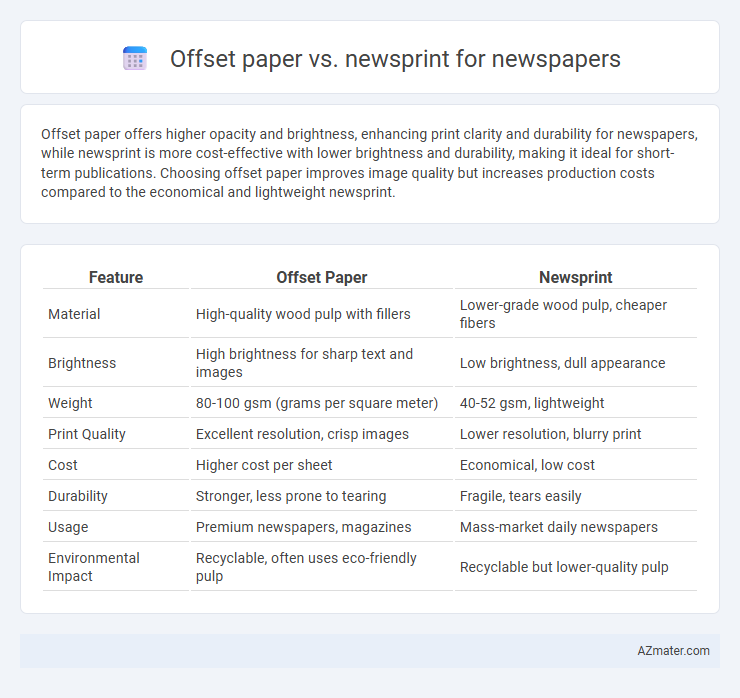Offset paper offers higher opacity and brightness, enhancing print clarity and durability for newspapers, while newsprint is more cost-effective with lower brightness and durability, making it ideal for short-term publications. Choosing offset paper improves image quality but increases production costs compared to the economical and lightweight newsprint.
Table of Comparison
| Feature | Offset Paper | Newsprint |
|---|---|---|
| Material | High-quality wood pulp with fillers | Lower-grade wood pulp, cheaper fibers |
| Brightness | High brightness for sharp text and images | Low brightness, dull appearance |
| Weight | 80-100 gsm (grams per square meter) | 40-52 gsm, lightweight |
| Print Quality | Excellent resolution, crisp images | Lower resolution, blurry print |
| Cost | Higher cost per sheet | Economical, low cost |
| Durability | Stronger, less prone to tearing | Fragile, tears easily |
| Usage | Premium newspapers, magazines | Mass-market daily newspapers |
| Environmental Impact | Recyclable, often uses eco-friendly pulp | Recyclable but lower-quality pulp |
Introduction: Offset Paper vs Newsprint
Offset paper and newsprint serve distinct purposes in newspaper production, with offset paper offering higher brightness, smoother texture, and superior ink absorption for sharper images and text. Newsprint, a more economical choice, is lightweight, made from low-quality wood pulp, and designed for quick printing cycles despite its lower durability and brightness. Selecting between offset paper and newsprint depends on factors like print quality requirements, budget constraints, and intended newspaper lifespan.
Key Characteristics of Offset Paper
Offset paper features a smooth, high-quality surface that enables sharp, vibrant print reproduction, making it ideal for detailed newspaper images and text clarity. It has superior brightness and opacity compared to newsprint, reducing show-through and improving overall readability. Offset paper's durability and resistance to smudging enhance the newspaper's professional appearance and longevity.
Defining Features of Newsprint
Newsprint is a low-cost, lightweight, and uncoated paper primarily used for printing newspapers, characterized by its high absorbency and relatively rough surface texture that allows quick drying of ink. Unlike offset paper, which is heavier and more refined for high-quality prints, newsprint is designed for short-term use and easy recyclability. Its lower brightness and opacity levels help improve contrast in black-and-white text, making it ideal for mass newspaper production.
Print Quality Comparison
Offset paper offers superior print quality for newspapers due to its smoother surface and higher brightness, enabling sharper text and more vibrant images. Newsprint, being more porous and less bright, often results in lower resolution prints with less color intensity, making it suitable for cost-effective, high-volume printing. The choice between offset paper and newsprint directly impacts clarity, detail, and overall visual appeal in newspaper production.
Durability and Lifespan
Offset paper offers superior durability compared to newsprint, maintaining print quality and structural integrity for extended periods, making it ideal for newspapers intended to be kept or archived. Newsprint, while cost-effective and lightweight, tends to yellow and become brittle faster due to its lower lignin content and acidic nature, resulting in a shorter lifespan. The choice between offset paper and newsprint significantly impacts the newspaper's longevity, especially under varying environmental conditions like humidity and sunlight exposure.
Cost Differences
Offset paper typically costs more than newsprint due to its higher quality, brighter finish, and greater durability, making it suitable for premium newspapers. Newsprint remains the most economical choice, characterized by its lower price, reduced weight, and uncoated texture, ideal for high-volume, budget-conscious newspaper printing. Cost savings with newsprint can be significant, often reducing paper expenses by 30% to 50% compared to offset paper, impacting overall production budgets.
Environmental Impact
Offset paper for newspapers offers higher recyclability and lower ink absorbency, reducing chemical pollution compared to newsprint, which often contains higher levels of fillers and additives that can hinder recycling processes. Newsprint is generally made from a higher percentage of recycled fibers but consumes significant water and energy during production, contributing to greater environmental footprint. Choosing offset paper can support sustainability goals by improving paper quality and recyclability while minimizing deforestation and chemical waste.
Readability and Visual Appeal
Offset paper offers superior readability and visual appeal for newspapers due to its smooth surface, which enhances ink absorption and produces sharper, more vibrant images and text. In contrast, newsprint's coarser texture and lower brightness result in duller visuals and slightly less clarity, though it remains cost-effective for high-volume printing. Readers tend to prefer offset paper newspapers for a more comfortable reading experience and crisper photo reproduction.
Common Applications in Newspaper Publishing
Offset paper is widely used in newspaper publishing for high-quality editions requiring sharp text and vibrant images, often seen in Sunday supplements and special features. Newsprint is primarily utilized for daily newspapers due to its cost-effectiveness and adequate print quality for large-volume production. Both materials are essential, with offset paper favored for durability and clarity while newsprint supports economical mass distribution.
Choosing the Right Paper for Newspapers
Offset paper offers higher quality printing with smoother texture and better ink absorption, ideal for sharper images and vibrant colors in newspapers. Newsprint is cost-effective, lightweight, and widely used for mass production of daily newspapers, prioritizing affordability and quick turnover. Choosing the right paper depends on balancing budget constraints, desired print quality, and publication frequency to meet editorial and reader expectations.

Infographic: Offset paper vs Newsprint for Newspaper
 azmater.com
azmater.com